Tessa R. Grasswitz, New Mexico State University, Agricultural Science Center, Los Lunas, NM
David R. Dreesen, Natural Resources Conservation Service Plant Materials Center, Los Lunas, NM
Introduction
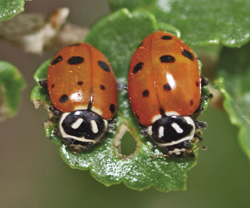
There is a wide variety of naturally occurring beneficial insects that can help keep pest insects under control if they are given a chance. Sadly, however, these insects are often misidentified and in some cases are mistaken for pests, leading to unnecessary and counter-productive insecticide applications. This publication, funded by the Western IPM Center, is intended to prevent such mistakes by highlighting some of the beneficial insects commonly found in New Mexico farms and gardens. Tips and suggestions on how to attract and retain such insects are also included.
Attracting and retaining beneficial insects
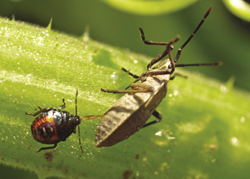 `
`
Spined soldier bug nymph attacking squash bug nymph.
Like all insects, beneficial species have three basic needs – food, water, and shelter. As far as food is concerned, although these species are predatory or parasitic for at least part of their life cycle, many of them need floral resources (nectar and/or pollen) at various times. Such resources can sustain these insects when prey is scarce, help them live longer, or lay more eggs. One way of attracting these insects to your garden or farm is therefore to plant a mixture of so-called ‘insectary plants,’ which can provide nectar and pollen all season long if properly cared for. Since beneficial insects differ in the size and structure of their mouthparts, not all flowers are equally accessible to all insects. Hence, to benefit the maximum number of beneficial insects, the flower mixture should contain a diversity of species with different bloom periods, flower sizes, structures, and colors. A basic core mixture of insectary plants for New Mexico has been developed at New Mexico State University’s Los Lunas Agricultural Science Center and the suggested species are illustrated below.
Suggested insectary plants for New Mexico
The species above form a suggested ‘core mix’ of quick-maturing annual plants that are readily available and easy to grow from seed. With the exception of the early-flowering California bluebell, they should bloom for the entire summer—particularly if dead flowers are removed from time to time before they set seed. Additional species can be added, but try to avoid double-flowered varieties, which can be hard for insects to access.
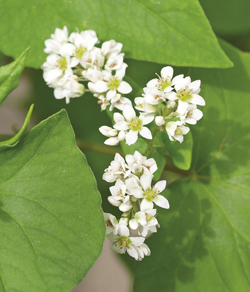
Buckwheat ( Fagopyrum esculentum)
col-sm-6 col-md-3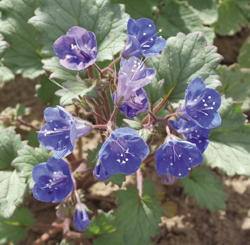
California bluebell ( Phacelia campanularia)

Dill ( Anethum graveolens)
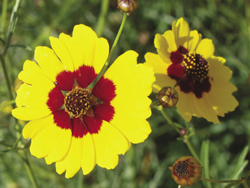
Plains coreposis ( Coreopsis tinctoria)
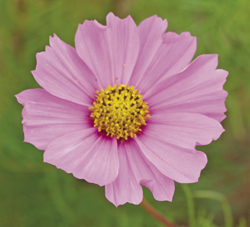
Garden cosmos ( Cosmos bipinnatus)
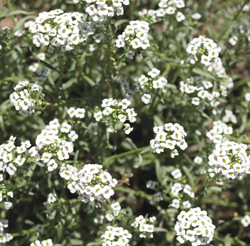
Alyssum ( Lobularia maritima)
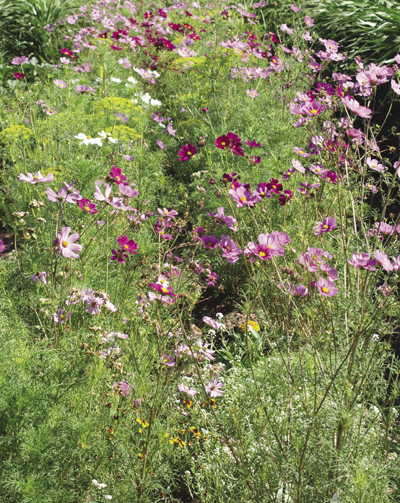
Row of insectary plants in full bloom.
Other ways to conserve beneficial insects
In addition to providing floral resources, a number of other measures can improve conditions for beneficial insects. Remember that even organically-approved insecticides can be toxic to such species, so minimize their impact by practicing integrated pest management (IPM). Some systemic insecticides (e.g., imidacloprid) can move within the plant and reach damaging concentrations in nectar, so try to avoid such products.
Provide a source of clean water, for example by filling a shallow plant saucer with pebbles and adding water until they are partly submerged. The exposed parts of the pebbles provide landing sites for predatory wasps and other useful insects. To avoid encouraging mosquitoes, empty the container every few days and allow it to dry out for several hours before refilling.
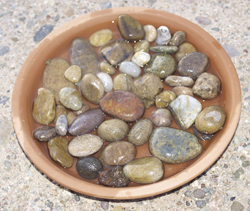
Water dish with pebbles.
Many beneficial insects overwinter in the adult stage in the top layers of soil, in plant litter, or under the rough bark of trees. The value of providing a permanent (or semi-permanent) area of such overwintering habitat has not been extensively researched, but is something to consider. A strip of clump-forming perennial clover (e.g., Trifolium pratense), perhaps in combination with a native bunch grass such as sideoats grama ( Bouteloua curtipendula), could be used to form such a refuge. Beneficial invertebrates found overwintering in this type of habitat include spiders, adult ladybird beetles, ground beetles, rove beetles, brown lacewings, parasitic wasps, nabid bugs, and big-eyed bugs.
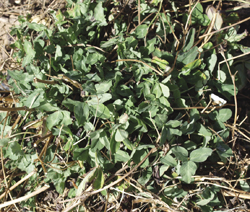
Clump-forming red clover ( Trifolium pratense) can provide overwintering habitat for beneficial insects.
Common beneficial insects of New Mexico
1. Beetles (Order: Coleoptera)
(i) Ladybeetles/Ladybird beetles (Family: Coccinellidae)
Most people are familiar with the adults of these beetles, particularly the common red and black convergent ladybeetle. However, the egg, larval, and pupal stages are less well known, and the larval stages in particular are often mistaken for pests. In fact, it is the larva that is the most voracious stage of the life cycle. Keep in mind, too, that there are many different species of these beetles in New Mexico, with various colors and patterns. Most species will eat aphids and other small, soft-bodied pests, and some species are specialist predators of spider mites.
Adult ladybird beetles
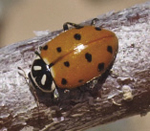
Hippodamia convergens
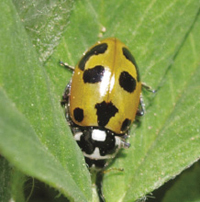
Hippodamia parenthesis
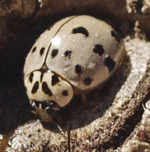
Olla v-nigrum

Ladybird egg mass

Larval stage
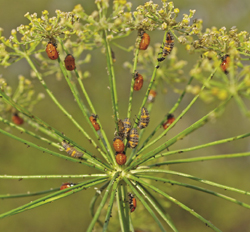
Flower head of dill with ladybird larvae and pupae
1. Beetles (Order: Coleoptera)
(ii) Ground beetles (Family: Carabidae)
These beetles are fast-moving, relatively large predators that attack a wide range of insect prey; a few species eat seeds and play a role in reducing the weed seed bank in the soil. They are typically black in color, often with a metallic sheen. Since they are nocturnal, they often pass undetected in the farm and garden, even though they may be present in high numbers. At first glance they may be mistaken for the large, black ‘darkling’ beetles (Family: Tenebrionidae) that are active during the day (particularly in desert areas), but differ in having a much flatter abdomen. The larval stages develop in the soil (for up to 2 years, depending on species) and prey on other soil-dwelling organisms, including some pests.
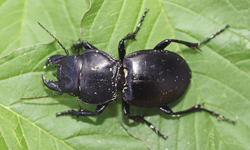
Adult ground beetle. Note large mandibles.
1. Beetles (Order: Coleoptera)
(iii) Rove beetles (Family: Staphylinidae)
These insects are unique among the beetles in having very short wing cases (elytra) that leave most of the abdominal segments exposed. This allows them to flex the abdomen upwards and towards the head in a defensive posture that resembles a scorpion. They cannot sting, however, and instead capture their prey with their mandibles. They vary in size from a few millimeters to 1-2 cm and consume a range of prey, including insect eggs, aphids, and small moth larvae. The larval stages live in the soil and feed on other invertebrates.

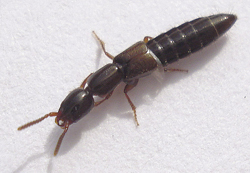
Typical rove beetles. Note short wing cases and exposed abdominal segments. (Photos by Mick E. Talbot)
1. Beetles (Order: Coleoptera)
(iv) Soft-winged flower beetles (Family: Melyridae)
As their name suggests, these beetles are often found on flowers, although they are common and widespread in other habitats, including alfalfa fields. They are often brightly colored, sometimes with a metallic sheen. Some species have enlarged basal antennal segments. Both adults and larvae are predatory, with the latter usually being found in the soil, in leaf litter, or under bark.
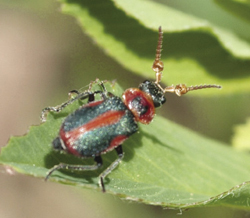
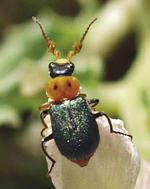
Two species of soft-winged flower beetle.
2. True bugs (Order: Hemiptera)
(i) Big-eyed bugs (Geocoris species)
Small, inconspicuous insects (approximately 5 mm long) that are very common in both garden and agricultural settings. Both adults and immatures (‘nymphs’) are readily identified by their broad head with large eyes projecting from the sides; nymphs are similar in shape to adults but are smaller and lack fully functional wings. Adults are usually brown or reddish in color and the nymphs a paler brown/grey. As true bugs, all stages have piercing mouthparts and feed by sucking the liquid contents from their prey (insect eggs, aphids, small moth larvae, etc.).
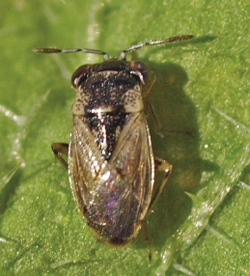
Adult big-eyed bug
2. True bugs (Order: Hemiptera)
(ii) Minute pirate bugs (Family: Anthocoridae)
At approximately 2-3 mm long, these are among the smallest of our common predators. In spite of their small size, however, the adults are easily recognized by their black and white ‘checkerboard’ appearance. The immature stages are brown and orange. Both adults and nymphs will tackle a variety of prey, including whiteflies, mites, insect eggs and newly hatched larvae, aphids, and thrips. These insects can sustain themselves on pollen when prey is scarce and hence are often found in flowers.
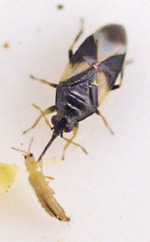
Adult pirate bug feeding on thrips.
2. True bugs (Order: Hemiptera)
(iii) Damsel or nabid bugs (Family: Nabidae)
The nabids or damsel bugs are a uniform dull brown color (both as adults and nymphs) and are longer and more slender than big-eyed bugs (approximately 9-10 mm long). They are common in both farm and garden habitats, and are good ‘generalist’ predators, tackling a variety of prey. They overwinter in the adult stage in cracks and crevices in the soil or in leaf litter.
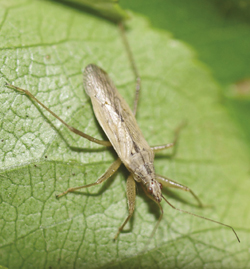
Adult nabid bug. The immature stages look very similar, but lack fully developed wings.
2. True bugs (Order: Hemiptera)
(iv) Spined soldier bug ( Podisus maculiventris)
Although many stink bugs are plant-feeding pests, the spined soldier bug is an excellent predator found in a variety of crop habitats, including orchards, vegetables, and row crops. The adult (approximately 14 mm long) is a drab brown color, with characteristic pointed ‘shoulders’ that give the species its common name. Newly hatched nymphs are red and black, superficially resembling an adult ladybird beetle, but with much longer antennae. As the nymphs develop, they lose their red color and become much paler. This species will attack a broad range of prey – sometimes taking on insects much larger than themselves.
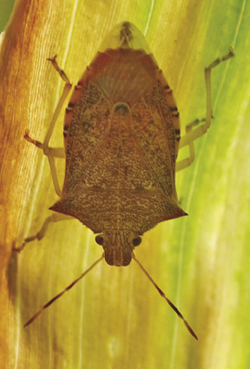
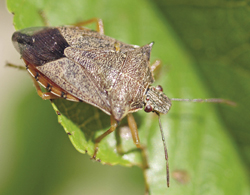
Spined soldier bug adults. Note sharply pointed ‘shoulders.’
Spined soldier bug immatures:
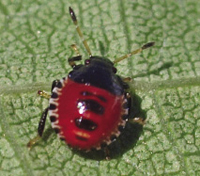
1st instar
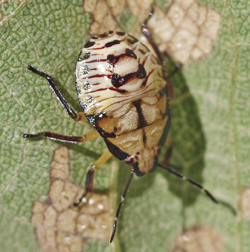
Older nymph
2. True bugs (Order: Hemiptera)
(v) Assassin bugs (Family: Reduviidae)
This is one of the largest families of true bugs, and includes the blood-sucking ‘kissing bugs’ ( Triatoma species) as well as useful insect predators. Kissing bugs are not normally found in crop or garden situations, but even the assassin bugs that prey exclusively on other insects can inflict a painful bite if handled roughly. The beneficial members of this family are quite diverse in size, color, and structure; some have enlarged forelegs that help with prey capture, while the so-called ‘ambush bugs’ hide in flowers (usually yellow ones, where they are well-camouflaged) and capture other flower visitors.
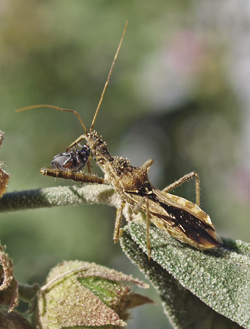
Assassin bug with prey
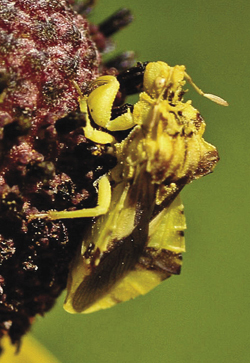
Ambush bug. Note front legs adapted for prey capture. (Photo by Alicia Lynn )
3. Lacewings (Order: Neuroptera)
There are two families of lacewings: green lacewings (Family Chrysopidae) and brown lacewings (Family Hemerobiidae). In summer, adult green lacewings will come to porch lights, but brown lacewings are much more reclusive and are rarely seen. Both groups lay their eggs on leaves, close to potential prey. Those of green lacewings are ‘stalked’ and are usually found on the undersides of leaves, either singly or in groups, depending on species. In both families, it is the larvae that are the main predatory stage; they have large, sickle-shaped mandibles that are inserted into soft-bodied prey (e.g. aphids, small caterpillars, etc), which are then sucked dry.
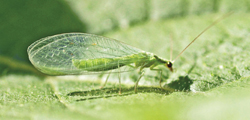
Adult green lacewings
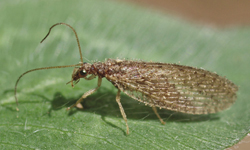
Adult brown lacewings
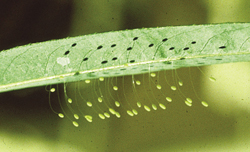
Green lacewing eggs. (Photo by Whitney Cranshaw, CSU, Bugwood.org)
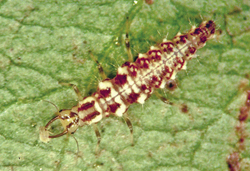
Green lacewing larva. (Photo by Bradley Higbee, Para-mount Farming, Bugwood.org)
4. Beneficial flies (Order: Diptera)
(i) Hoverflies (Family: Syrphidae)
Adult hoverflies can look superficially like wasps, but have only 1 pair of wings and very short antennae. The adults feed on nectar and pollen, and so are often seen on flowers (or hovering over them prior to landing). The females lay their eggs close to aphid colonies, on which the larvae feed. The pupal stage is immobile, somewhat pear-shaped, and normally found on the same plant on which the larva developed.
Adult hoverflies. Note short antennae compared to wasps
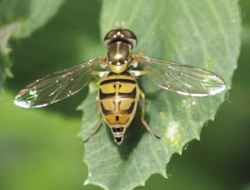
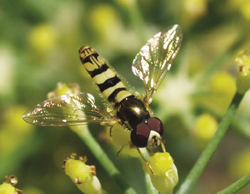
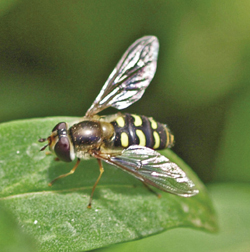
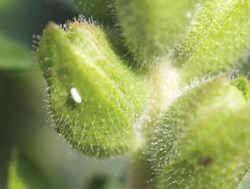
Hoverfly egg on snapdragon bud
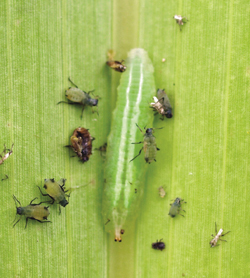
Larval stage with aphids
4. Beneficial flies (Order: Diptera)
(ii) Tachinid flies (Family: Tachinidae)
The flies in this family are parasitoids, i.e., the females lay their eggs on or in the bodies of other insects, and when the fly larvae hatch, they gradually consume the host until it dies and the fly larvae pupate. Many tachinids attack larval moths and butterflies, although some species parasitize other insect groups (e.g., cucumber beetles). The adults often resemble large houseflies, but have a more bristly abdomen. They sustain themselves on nectar and pollen, and so are often found on flowers during the summer.
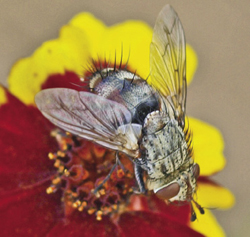
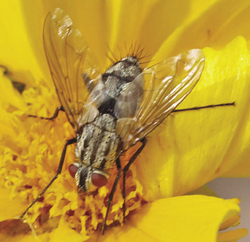
Adult tachinid flies. Note bristly abdomen.
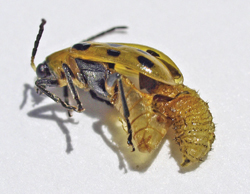
Mature tachinid larva emerging from dead host (cucumber beetle) prior to pupating.
5. Wasps (Order: Hymenoptera)
(i) Parasitic wasps (various families)Like tachinid flies, parasitic wasps behave as parasitoids, i.e., the adults are free-living, feeding mainly on nectar, while the egg and larva (and often the pupal stage) develop inside other insects, eventually killing them. Since parasitic wasps have to overcome their hosts’ internal immune defenses, they are much more restricted in the range of insects that they can successfully attack than are predators. However, they are extremely efficient at finding their hosts, and can be very effective biological control agents. Parasitic wasps range in size from just a few millimeters (e.g., species that parasitize the eggs of other insects) to several centimeters in length. The females of species that attack concealed hosts (e.g., those living deep within plant tissues) often have a long ‘ovipositor’ (egg-laying tube) extending from the tip of the abdomen; although this is sometimes mistaken for a ‘stinger,’ these species are harmless to humans.



Two larger species in which the long egg-laying tube (ovipositor) is visible.
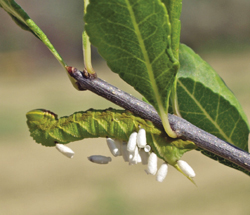
Hornworm larva that has been attacked by a parasitic wasp.

The white structures are the pupal cocoons of the parasitoid. Pupal cocoons of a parasitic wasp and the dead remains of the cabbage white butterfly larva in which they developed.
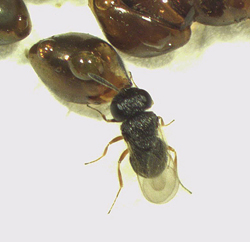
A minute parasitic wasp that attacks the eggs of squash bugs.
5. Wasps (Order: Hymenoptera)
(i) Predatory wasps (various families)
New Mexico has a large and diverse array of predatory wasp species, some of which form colonies while others are ‘solitary’ – i.e., each female constructs her own individual nest, often in the soil, but also in other habitats such as plant stems or pre-existing holes in dead wood. Species in one sub-family construct mud ‘pots’ that they provision with prey items for their larvae. Although wasps are viewed as pests by many people, they will not normally sting unless provoked and are valuable predators; different species attack moth caterpillars, scarab beetle larvae (‘white grubs’), grasshoppers, stink bugs, and various other pests. Adult wasps will feed on nectar and hence are often seen on flowers.
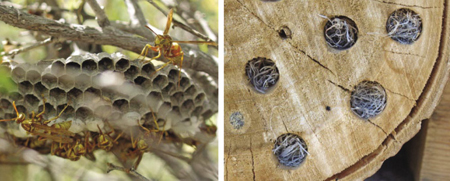
Paper wasp colony, entrance holes to nests of solitary grass-carrying wasps
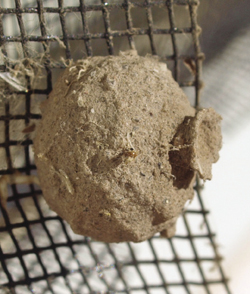
Potter wasp larval cell.
Examples of predatory wasps found in New Mexico.
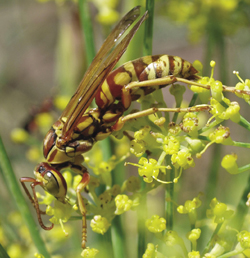
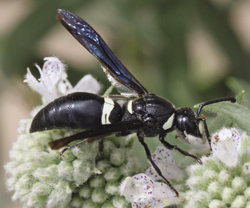
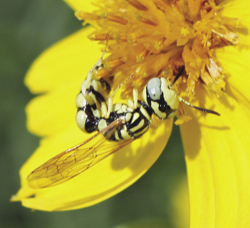
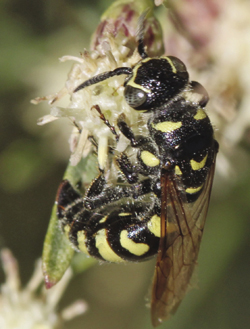
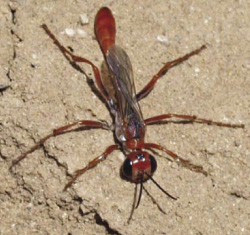
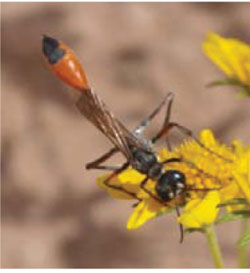
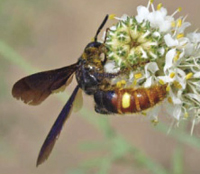
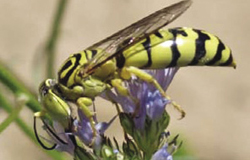
For Further Reading
H-168: Selection and Use of Insecticides for Organic Production:
https://pubs.nmsu.edu/_h/H-168/
H-169: Using Insectary Plants to Attract and Sustain Beneficial Insects for Biological Pest Control:
https://pubs.nmsu.edu/_h/H169/
CR-655: Integrated Pest Management (IPM) for Home Gardeners:
https://pubs.nmsu.edu/_circulars/cr-655/welcome.html
Flint, M. L. and Dreistadt, S. H. 1998. Natural enemies handbook: the illustrated guide to biological pest control. University of California. 154 pp.
Helyer, N., Brown, K and Cattlin, N. D. 2012. Biological control in plant protection: a colour handbook. Manson Publishing Ltd. 160 pp.

To find more resources for your business, home, or family, visit the College of Agricultural, Consumer and Environmental Sciences on the World Wide Web at aces.nmsu.edu
To find more resources from the Natural Resources Conservation Service Plant Materials Center: https://www.nrcs.usda.gov/wps/portal/nrcs/main/plantmaterials/pmc
Contents of publications may be freely reproduced for educational purposes. All other rights reserved. For permission to use publications for other purposes, contact pubs@nmsu.edu or the authors listed on the publication.
New Mexico State University is an equal opportunity/affirmative action employer and educator. NMSU and the U.S. Department of Agriculture cooperating.


